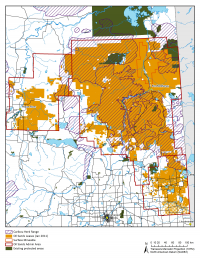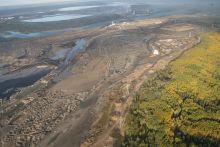I would hazard a guess that more money has been spent on researching the needs of woodland caribou than any other wild animal in Alberta. Tens-of-millions of dollars have been invested to track caribou habitat requirements, food sources, impacts from industry and predators as well as to record their steady decline toward extinction in this province.
My own experience with woodland caribou dates back almost 14 years when I came to Alberta to attend graduate school. My research examined the impacts of oil and gas development on woodland caribou. At the time, as a keen young biologist, I somewhat naively assumed that scientific information — funded by government and industry — would be used to inform development decisions and protect species at risk in the pursuit of balancing resource development with caribou conservation. How wrong I was!
Despite this solid research, there has been no meaningful attempt from governments to use this information to protect caribou habitat in northeastern Alberta. Nor has there been any management of industrial development in a way that would enable caribou to co-exist on the landscape.
 How, you might ask, is this possible in a country like Canada that is supposed to have strict environmental laws, like the Species At Risk Act, which requires the federal government to ensure the survival of threatened and endangered species across the country, including woodland caribou? The enforcement of the Species at Risk Act is especially important where provinces or territories are not taking the steps necessary to protect species within their own borders.
How, you might ask, is this possible in a country like Canada that is supposed to have strict environmental laws, like the Species At Risk Act, which requires the federal government to ensure the survival of threatened and endangered species across the country, including woodland caribou? The enforcement of the Species at Risk Act is especially important where provinces or territories are not taking the steps necessary to protect species within their own borders.
That's why the Pembina Institute will be in Federal Court in Edmonton on June 22 in an attempt to force the federal government to finally uphold its legal duty to protect woodland caribou.
Clearly, Alberta has failed its caribou, which continue to decline precipitously. The Government of Alberta in its draft Lower Athabasca Integrated Regional Plan, has even signaled that it requires another two years to develop a plan for caribou — this on top of the two decades of dithering so far.
Meanwhile, caribou populations continue to decline. One herd south of Fort McMurray has seen its population drop by around 60 per cent since I started my research all those years ago. While Alberta has not kept its side of the bargain to ensure caribou persist in Alberta, the federal government has also missed deadline after deadline to protect their habitat. Yet under the Act it was supposed to have released a recovery strategy for woodland caribou over four years ago. The clock is still ticking.
Current and proposed oilsands development — especially in situ oilsands development — represents one of the biggest threats to woodland caribou. Ninety-five per cent of all caribou ranges in the Lower Athabasca region are open to industrial development while over 40,000 square kilometres of caribou range have been leased to the oilsands industry across Alberta.
The Pembina Institute has provided constructive and reasonable recommendations on ways to protect caribou by participating in government processes and developing effective management plans that allow responsible oilsands development, but all to no avail.
Prior to launching the lawsuit last summer we also wrote to the Federal Minister of Environment asking for emergency protections of the remaining caribou herds. We have yet to receive a response.
Now, as a last resort, the Pembina  Institute along with Alberta Wilderness Association and represented by lawyers at Ecojustice, have filed a judicial review to protect caribou before it is too late. Our application is being heard along with three First Nations in northeastern Alberta that are also arguing that woodland caribou must be protected.
Institute along with Alberta Wilderness Association and represented by lawyers at Ecojustice, have filed a judicial review to protect caribou before it is too late. Our application is being heard along with three First Nations in northeastern Alberta that are also arguing that woodland caribou must be protected.
We are seeking a declaration from the Court that the Minister's refusal to recommend an emergency order for the protection of the woodland caribou herds under subsection 80(2) of the Species at Risk Actis unlawful and unreasonable. Our lawyers are arguing that the Minister must be compelled to comply with his duties under the Act to recommend an emergency order to protect these caribou herds.
What does this mean for the oilsands? It means a lot of unnecessary risk for companies and their shareholders.
As my colleague Jennifer Grant argued in an earlier blog, oilsands companies are playing a high stakes version of Russian roulette by knowingly purchasing oilsands leases in declining caribou habitat, even though science has shown this habitat is critical for the recovery of the species.
Ironically, by failing to set appropriate and balanced rules for industrial development up front, the federal government, along with the Government of Alberta, is threatening the viability of future oilsands projects by failing to demonstrate where caribou habitat will be protected in Alberta.








